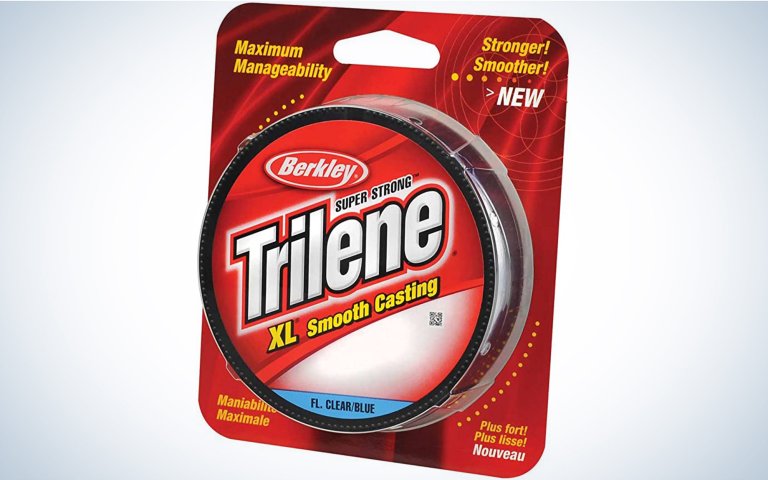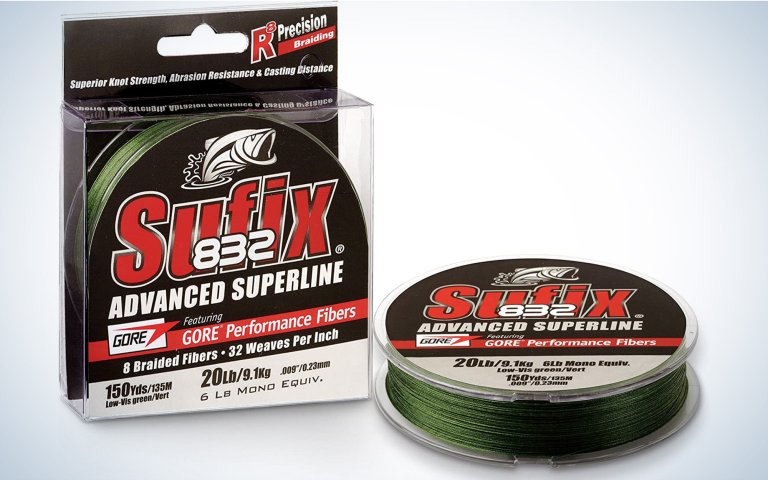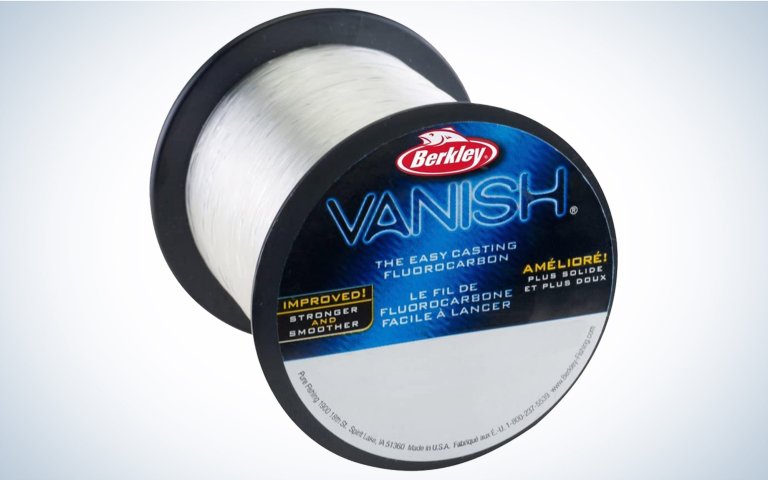We may earn revenue from the products available on this page and participate in affiliate programs. Learn More ›
Hundreds of different fishing line types, brands, sizes, diameters, properties, and strengths (pound tests) can make selecting one difficult. But fishing line can be broken down logically according to its applications to certain types of fishing. Each line type has specific properties that enable anglers to achieve varying goals in their sport.
Identifying the target species, fishing style, habitat, lures and baits, and the skill of the angler all have bearing in choosing the best line for the job. From trolling spoons for oversized pike and steelhead to deep jigging leadheads for walleyes and smallmouths, to working top-water frogs or spinner-baits for bass, there’s a specific kind of line to help anglers get the best results. There are three major types of fishing line employed today: monofilament, braid, and fluorocarbon.
Monofilament Line
Monofilament has been the standard line for millions of anglers for over half a century. Even today, inexpensive mono offers excellent value. It casts well with spinning or plug tackle and is easy to handle and tie knots with.
Why It’s Great
Because mono stretches under pressure, it can be very forgiving when you’re fighting a large fish. However, it takes a solid hook set with mono to drive hooks deep in fish, or into hard-mouthed fish like muskies. Mono is softer than fluorocarbon, and some anglers believe it’s more forgiving of abrasions than fluorocarbon line because mono “gives” rather than chaffs when contacting cover. However, some fisherman say fluorocarbon is better at abrasion resistance because it’s hard compared to limper monofilament.
Knots tie well with mono and cut cleanly with clippers for a smooth connection. In lighter tests, under about 10 pounds, mono is the choice of most anglers, because it casts light lures with spinning gear easily, and it’s easy to handle when rigging hooks, sinkers, snaps, and swivels.
Monofilament Line Shortcomings
Monofilament line has significant stretch. This can be an asset for some fishing and fishermen, but it makes for loss of lure feel, and some anglers have a difficult time detecting light strikes. Mono stretch also requires anglers to make a solid effort when setting hooks to drive barbs deeply into taking fish.
Another shortcoming is that monofilament twists, which causes a multitude of casting and retrieving problems. Monofilament line twist can be an especially troublesome problem when trolling lures, because of their inherent wiggle and wobble. Choice placement of swivels in mono near lures and baits can diminish line twist, but swivels are visible to spooky fish in clear water.
How And Why Top Anglers Use Mono
There are many applications for monofilament, and since it’s been around for decades, many top anglers are committed to it, like veteran fisherman, Jake Markris, of Fairhope, Alabama.
“I guess I use monofilament line the most because it’s what I was raised on,” he says. “I never felt I was at a disadvantage even when braid was introduced. Of course, braid has many advantages, such as no stretch, better hook sets, more sensitivity, longer life, etc. I don’t disagree with any of those. I just always felt if it wasn’t broke, why fix it.” Markris adds that monofilament is very cheap; it comes on and off the reel smoothly, and it makes it easier to tie knots quickly.

Montanan Jim Kalkofen prefers monofilament in light tests for stream trout fishing with small lures and also for panfishing. “It’s easier casting far with light lures using monofilament,” says the long-time Midwest walleye tournament angler and co-owner of targetwalleye.com.
Kalkofen also opts for monofilament for deep-jigging, Rapala type lures and Moonshine Shiver Minnows, which he believes provide better hookups and more walleyes in the boat.
“I like soft mono with high abrasion resistance when using bottom-bumping lures like jigs and plastic worms for bass,” says Sammy Lee, host of the long-running syndicated radio show Tight Lines, from Alabama. “For this type of fishing, I want line with a little bit of stretch, so when I set the hook, the line doesn’t break.”
Read Next: How to Choose the Right Fishing Hook the First Time
Sammy notes that monofilament absorbs water during the course of fishing, providing an extra 5 to 7 percent elasticity. This ensures that the line won’t part during a hook set when using jigs and plastic worms.
Fishing Hall of Fame angler and host of the Lake Commandos TV show, Steve Pennaz, of Minnesota, uses all types of lines and opts for monofilament often during his fishing travels.
“Mono is a great line,” he says. “It’s neutrally buoyant, clear, strong, very inexpensive, and offers stretch (up to 25 percent)—a great option for most everyday fishing. I turn to mono when fishing most top-water lures for bass, especially poppers. Mono doesn’t sink like fluorocarbon or offer a darker silhouette like braid, so it’s ideal for any surface lure fishing.”
Pennaz also chooses light mono for panfish, especially when rigging slip floats.

Florida fishing guide and state wildlife officer Chris Holleman wants limp monofilament leaders when he uses live baits—especially with fish-finder rigs and when float fishing with slip-bobber rigs.
For trout and steelhead, Freshwater Fishing Hall of Fame Angler, Buzz Ramsey, of Washington, mostly uses monofilament. “Being able to see my line is important, so a hi-vis mono is mostly what I use. And so fish won’t see or shy from it, I always employ a fluorocarbon leader,” he explains. “My preferred monos are Berkley Trilene XL for trout—as it’s smooth casting—and the tougher, more durable Trilene XT or Big Game when chasing steelhead.”
Braided Line
Braided line has boomed in popularity in recent years due to comparatively new improvements that have resulted in high abrasion resistance, very fine diameter per test, and superb casting characteristics.
Why It’s Great
Perhaps braid’s biggest asset is that it has virtually no stretch, thus it’s extremely sensitive—making it a top choice for deep water fishing and for “feeling” the slightest bite from fish. However, no stretch can be detrimental if anglers overplay fish, which can pull out or straighten hooks, resulting in a loss.
Read Next: Best Fishing Lines for Bass
Braided Line Shortcomings
It is more expensive than monofilament, and it can be difficult to tie knots in well, as braid tends to slip. Many old stand-by knots that work great with monofilament, such as the improved clinch knot and blood knot, will not hold in braided line.
Another property of braid is that it must be cut with scissors when trimmed following knots. Nail clippers will not cut braid.
Braid can be a godsend in heavy tests of 20, 40, and 80 pounds or more. But in very light tests, under about 10 pounds, it is so fine in diameter that it’s difficult for some folks to handle and cast. Lastly, most anglers feel the need to use a leader of monofilament or fluorocarbon between braid and a hook to make the terminal end more invisible to fish. This also helps prevent tangles in snaps, swivels, and hook split rings.
How And Why Top Anglers Use Braid
“I use Sufix 832 braid with a fluorocarbon leader for most clear water fishing applications,” says long-time and well respected multi-species angler, Rich Zaleski, of Connecticut. “For drop shot fishing in the clear waters of the Northeast, I use 6- or 8-pound braid with an 8-pound Seaguar ‘Invizx’ fluorocarbon leader.” For most other finesse applications in Northeastern bass fishing, Zaleski uses 10-pound braid with a fluorocarbon leader of 8- to 12-pounds, depending on the lure and cover he is working.
For spinner-bait and for flipping vegetation, Zaleski uses 20-pound braid, without a leader. “For top-water stripers and bottom fishing, I like 30-pound braid with a 20- or 25-pound monofilament leader,” he adds. “I want a little give in the leader in that situation.”

Zaleski adds that one of the primary reasons he uses braided line so much is it increases his sense of feel when working lures and baits—especially in deep water. He attributes this to its fine diameter and lack of stretch.
“Braid sharpens and intensifies the signals transmitted through the line from lures and fish,” he says. “I like to say using braided line is like fishing by braille. This is why I’m not much of a line watcher, and don’t use high-visibility lines. I let line feel do the job of staying in touch with lures and fish.”
As an executive with the G. Loomis Company in Washington, Bruce Holt fishes in lots of places for lots of species, and uses all types of fishing line depending on the situation. “I like 10-pound Power Pro braid with a 6-foot fluorocarbon leader for buzz-baits, spinner-baits, top-water lures, and frogs, especially in heavy pads or weeds,” Holt says. “Same for deep-water jigs, except I opt for 30-pound braid. For trolling, it’s braid with a leader.”
Holt also uses braid on the Columbia River when he plunks for steelhead. “It’s sort of like catfishing except we’re using prawns and Spin-N-Glo‘s on leaders with a dropper lead,” he explains. “The thinner diameter of the braid is good in deep, heavy current for this application. Same for sturgeon, except I use a Dacron leader and bait.”

Niagara River, New York, fishing guide, Ernie Calandrelli, uses braided line for walleye and smallmouth bass fishing because his customers need the sensitive line to feel bait bites from fish. For bigger game like salmon, trout, and steelhead, Calandrelli opts for monofilament line with fluorocarbon leaders. The extra stretch in the line compensates for the mistakes that inexperienced anglers make when playing bigger fish.
Fisherman, Barry Stokes, almost exclusively uses braided line on all his spinning reels. It tends to lay flat on the reel spool, he says, with much less memory coming off the spool during a cast. Wind knots are also less of a problem for Stokes when using braid compared to mono or fluorocarbon. “I even use braided line on my crappie spinning reels. When dock shooting for crappie, braid shoots much farther under docks than any other line.”
Sammy Lee uses 80- to 120-pound-test braided line when flippin’ for bass. “This is one condition where I do not want any stretch in my line. I need a line that has the ability to horse out lunkers from heavy cover quickly,” he says. “Some anglers use a fluorocarbon shock leader for flippin’, but I’ve found that it destroys lure action.”

Steve Pennaz uses braided line almost exclusively for flipping jigs and plastics on heavy-cover bass. But he’s encountered some situations in recent years where fluorocarbon line was far better for flipping because of its invisibility. In some cases, using fluorocarbon produced two or three times as many bass as more visible braid.
Pennaz says braided line is his first choice when making very long casts, or when moving a lure to set hooks in fish like pike or muskies. They can hold a lure like a vice with their dagger-like teeth.
“Crankbait trolling for walleyes and other species is perfect for braid, too, because I can clear a lure of weeds or moss without having to reel the lure all the way back to the boat.
“Deep jigging with hyper-sensitive, no-stretch braided line makes for solid hook-sets.”
Another important and often overlooked asset of braided line, when compared to mono and fluorocarbon, is that it doesn’t twist. Line twist can be deadly with mono, especially in lighter tests, and particularly when inexperienced anglers are in control.
Fluorocarbon
Fluorocarbon fishing line is a relatively new product that has been improved dramatically over the years. Its price has also come down from out of the stratosphere.
Why It’s Great
Similar in design to monofilament in that it’s extruded in a single strand, it is virtually invisible in even ultra-clear water because light passes through it. For this reason, anglers can use fluorocarbon in heavier pound tests than other lines that are more visible.
While fluorocarbon does stretch, in practical fishing it has less stretch than mono—though it is more elastic than braided line. It’s tough and resistant to abrasion. Newer versions of fluorocarbon are not as stiff as when it first entered the fishing market, which makes it more suitable to spooling on reels. Unlike mono, fluorocarbon doesn’t absorb water.
Fluorocarbon Line Shortcomings
Fluorocarbon can make it difficult to tie some knots, because it’s stiffer than mono or braid. Also, it sinks faster than mono, so for surface lures it’s not the best choice. But new-era fluorocarbon is quickly gaining lots of endorsements from plenty of top anglers.
How And Why Top Anglers Use Fluorocarbon Line
“Fluorocarbon has become my number one all-purpose line,” says Barry Stokes. “It’s limp and castable on my bait-casters, while still maintaining lots of strength and abrasion resistance. It’s also the clearest line on the planet with a zero refractive index. That means it’s the closest to transparent of anything other than water.” Stokes says he uses it almost exclusively for trolling and likes that it sinks and keeps lures lower in the water column.
“I long-line troll often for crappie with both jigs and crankbaits, and fluorocarbon helps a bunch,” he adds. “I use 6-pound-test for crappie trolling, and 10-pound test trolling for most everything else. I occasionally bump up to 14- or 17-pound-test if I’m trolling for big stripers or hybrids.”

Dave Mull uses 15-pound-test fluorocarbon when working cover for bass with chatter-baits and spinner-baits on bait-casting tackle because the line is abrasion-resistant. He prefers fluorocarbon over braid because it’s easier dealing with backlashes.
Sammy Lee reports that when fluorocarbon lines were introduced his fish catching ratio went through the roof. He was able to get small lures deeper, faster, and with better feel using fluorocarbon line.
“Plus, when fishing in winter with gloves on, rod feel of lure and fish is enhanced tremendously with fluorocarbon,” he explains. “Fluorocarbon lines sink faster and relay a bass strike even better than braided lines. Plus I don’t backlash my spinning reels nearly as much with fluorocarbon line—that’s a real asset in winter.”
Fishing Line FAQs
In general, fluorocarbon performs better than monofilament line. Fluoro is tough and abrasion resistant. It stretches, but not as much as mono, and it’s very versatile. Top anglers say it is the clearest line, making it transparent in the water. However, for topwater baits fluoro is not a good choice, because it sinks faster than mono. Also, fluoro is more expensive.
Braid is considered the strongest fishing line by diameter. In other words, it has a relatively smaller diameter per pound test than other line types. However, you can up the strength of any type of fishing line by increasing test weight.
Match the type of fishing line you choose to the type of fishing you intend to do, and follow the advice from the experts above. If price is no option and you want a good all-around line, go with fluorocarbon. If you want forgiving line that won’t break the bank, go with monofilament. If you intend to fish heavy cover, go with braid.



